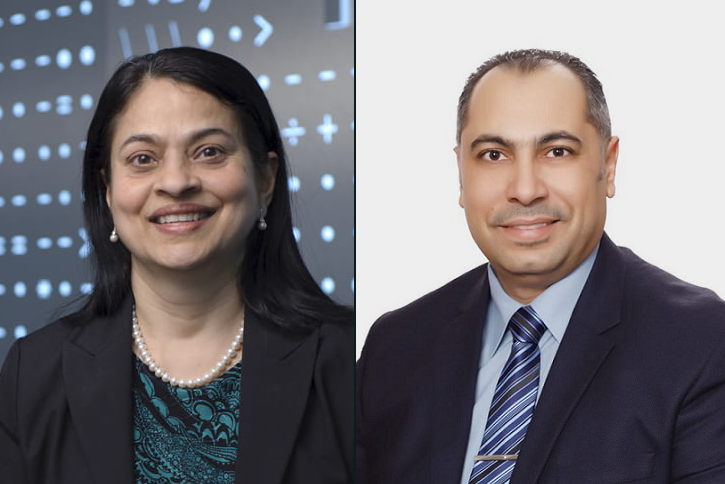
Anuradha Agarwal and Mohammad Salah.
Anuradha Agarwal, a principal research scientist at the MIT Microphotonics Center and Materials Research Laboratory, and Mohammad Salah, a mechatronics engineering professor from The Hashemite University, received the MIT-Jordan Abdul Hameed Shoman Foundation Seed Fund grant for their project, “Silicon recycling and sustainable manufacturing: A mechatronics and STEM education initiative for PV panels.”
Together they blended complementary strengths: Jordan’s experience in large-scale solar deployment and MIT’s leadership in advanced semiconductor technologies. Both Agarwal and Salah recently sat down with MIT-MENA to discuss the power of advancing research through global collaboration.
Why did you launch this collaboration?
A collaboration was launched between MIT’s NSF Convergence Accelerator Program, FUTUR-IC, and Mohammad Salah, a mechatronics engineering professor from The Hashemite University (HU) in Jordan. FUTUR-IC, which focuses on developing resource-efficient materials for the silicon semiconductor industry, recognized that these same innovations could be applied to the silicon solar cell sector. This realization sparked a natural partnership with HU Professor Mohammad Salah, whose expertise in mechatronics and automation offers new ways to improve solar panel manufacturing efficiency and recycling processes. Together, the collaboration aims to accelerate the adoption of sustainable, resource-efficient technologies that benefit both industries, human health, and the environment.
What inspired your research in this specific field? What are the broader real-world applications or societal impacts of your work?
The growing demand for AI-driven data centers has significantly increased global energy and resource consumption. Co-packaged optics (CPO) technology offers a promising solution by improving data transfer efficiency while drastically reducing energy, water, and chemical use. Building on this innovation, researchers are now extending resource-efficient semiconductor technologies into renewable energy applications—particularly solar energy. Applying these principles to solar panel design, production, and recycling supports a more sustainable global energy transition while reducing the detrimental impacts on human health and environmental footprint of high-tech industries.
How does collaboration with colleagues from Jordan and other cultures inform or advance research?
International collaboration enables the blending of complementary strengths: Jordan’s experience in large-scale solar deployment and MIT’s leadership in advanced semiconductor technologies. This partnership fosters not only scientific exchange but also cultural understanding among students and faculty. By combining Jordan’s extensive solar data and regional expertise with US advancements in materials science and automation, both partners can co-develop innovative solutions for more efficient solar panel manufacturing and end-of-life recycling. Such cooperation underscores how science can transcend borders to address shared global challenges.
What is your hope and desired outcome of international collaborations and this one in particular?
This partnership aims to cultivate a new generation of globally minded engineers and researchers. Students from HU will gain advanced knowledge in materials science and semiconductor processes, while MIT students will acquire hands-on experience in applied mechatronics and sustainable energy systems in real-world settings. The ultimate goal is to create scalable, environmentally responsible technologies for solar energy and to establish a long-term bridge between academia and industry in both regions.
What opportunities will this collaboration create for students and young researchers? Students will have the opportunity to participate in joint workshops, research exchanges, and lab visits between MIT and HU. They will engage in hands-on experiments, data analysis, and prototyping activities that combine materials science, automation, and renewable energy concepts. Such exposure helps students develop both technical and intercultural skills, preparing them for leadership roles in future green technologies.
What are the next steps for this initiative?
The team plans to organize research visits, collaborative design workshops, and pilot projects that demonstrate the integration of advanced semiconductor materials into solar cell and panel systems. Future efforts will also explore industry partnerships in both countries to translate laboratory results into scalable industrial solutions. The long-term vision is to establish a joint research and innovation hub that connects MIT, Jordanian universities, and regional industries.
The MIT-Jordan Abdul Hameed Shoman Foundation Seed Fund grant is offered through the MIT Global Seed Funds (GSF) program. Launched in 2008, GSF has awarded roughly $30 million to more than 1,300 high-impact faculty research projects across the world. Administered through the MIT Center for International Studies, GSF applications are now open, with a deadline of December 16.

